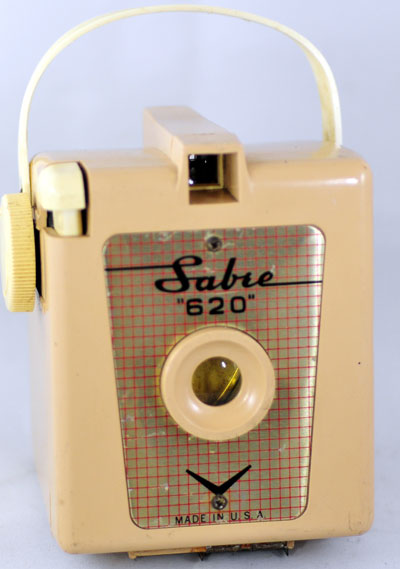Shaw-Harrison Sabre "620"
Specification

| Manufacturer | : | Shaw-Harrison |
|---|---|---|
| Produced | : | 1956 |
| Classification | : | Medium Format |
| Body Type | : | Box |
| Construction | : | Plastic |
| Film Type | : | 620 |
| Film Width | : | 62mm |
| ImageSize | : | 2¼ x 2¼ in |
| No. of Images | : | 12 |
| Lens Type | : | Meniscus |
| Focus Type | : | Fixed |
| Focal Length | : | 80mm |
| Focal Range | : | 5ft - inf. |
| Aperture Type | : | fixed |
| Aperture | : | f/16 |
| Shutter Type | : | Rotary |
| Shutter Speeds | : | I*(1/100 sec) |
| Size (w x h x d) | : | 85 x 110 x 90 mm |
| Weight | : | 268g |
| * Measured on this camera | ||
Art Deco Credentials
![]()
![]()
Acceptable: Modest and restricted
- Produced Post Art Deco period.
- Moulded coloured plastic body.
- Decorative faceplate.
- Crosshatch pattern
- Distinctive script font.
- Single chevron at bottom of faceplate.
Description
The Shaw-Harrison Sabre "620" is an all plastic simple box camera, with a simple snap shot shutter and a fixed focus meniscus lens. It has a decorative metal face-plate with a cross-hatch design. The camera was made in various colors including black, red, yellow, green, turquoise and beige. It has a reverse telescopic eye-level view finder. There are connections on the side to connect to a removable synchronized flash unit. It was capable of capturing twelve 2¼ x 2¼ inch exposures on number 620 roll film in color or black and white
It was distributed by the Shaw-Harrison Company of 44-01 11th Street, Long Island City, New York. It was made between 1956 and 1972.
How to Use
Find the manual here:- Manual for Sabre 620
This camera takes 620 film which is still available from selected photographic outlets. Although the actual film is the same as 120 film, the spools are different. The 620 spools are slightly shorter and have a smaller diameter. Do not use 120 film in this camera because it will jam and may snap. It is possible to cut down a spool of 120 film to fit or to re-spool some 120 film onto 620 spools in a darkroom or changing bag.
Don't forget to ask for your 620 spool back when getting the film developed.
This camera works best with ISO 100/125 film on a sunny day. ISO 160 film like Portra will work well.
This camera supports Instant mode only with a speed of about 1/100 sec. It has a single aperture settings of f/16. With a shutter speed of only 1/100 sec, make sure you brace the camera against your body or something solid and press the shutter smoothly to avoid camera shake.
If you don't want to bother with an exposure meter, follow the guide shown. It is based on the 'Sunny 16' rule. Film is so forgiving and will produce acceptable results even when over-exposed by 2 or 3 stops or under-exposed by 1 stop.
The table assumes that the sun is at least 30 degrees above the horizon - that's 10am - 5pm on a summers day in the UK.
Remember that the exposure guide in the manual may not be helpful as it is based on the use of old film with a low ISO value.
So, on a nice sunny day, it's simplicity itself. Just load film and snap away.
Using ISO 100/125 film - shutter speed 1/100s
| Weather Conditions | Shadow Detail | Aperture | Exposure |
|---|---|---|---|
 Sunny SunnySnow/Sand | Dark with sharp edges | f/16 | +1 Stops Overexposed Acceptable |
 Sunny Sunny | Distinct | f/16 | Good |
 Slight Overcast Slight Overcast | Soft around edges | f/16 | -1 Stops Underexposed Acceptable |
 Overcast Overcast | Barely visible | f/16 | -2 Stops Underexposed Not Acceptable |
 Heavy Overcast Heavy Overcast | None | f/16 | -3 Stops Underexposed Not Acceptable |
 Open Shade Open Shade/Sunset | None | f/16 | -4 Stops Underexposed Not Acceptable |